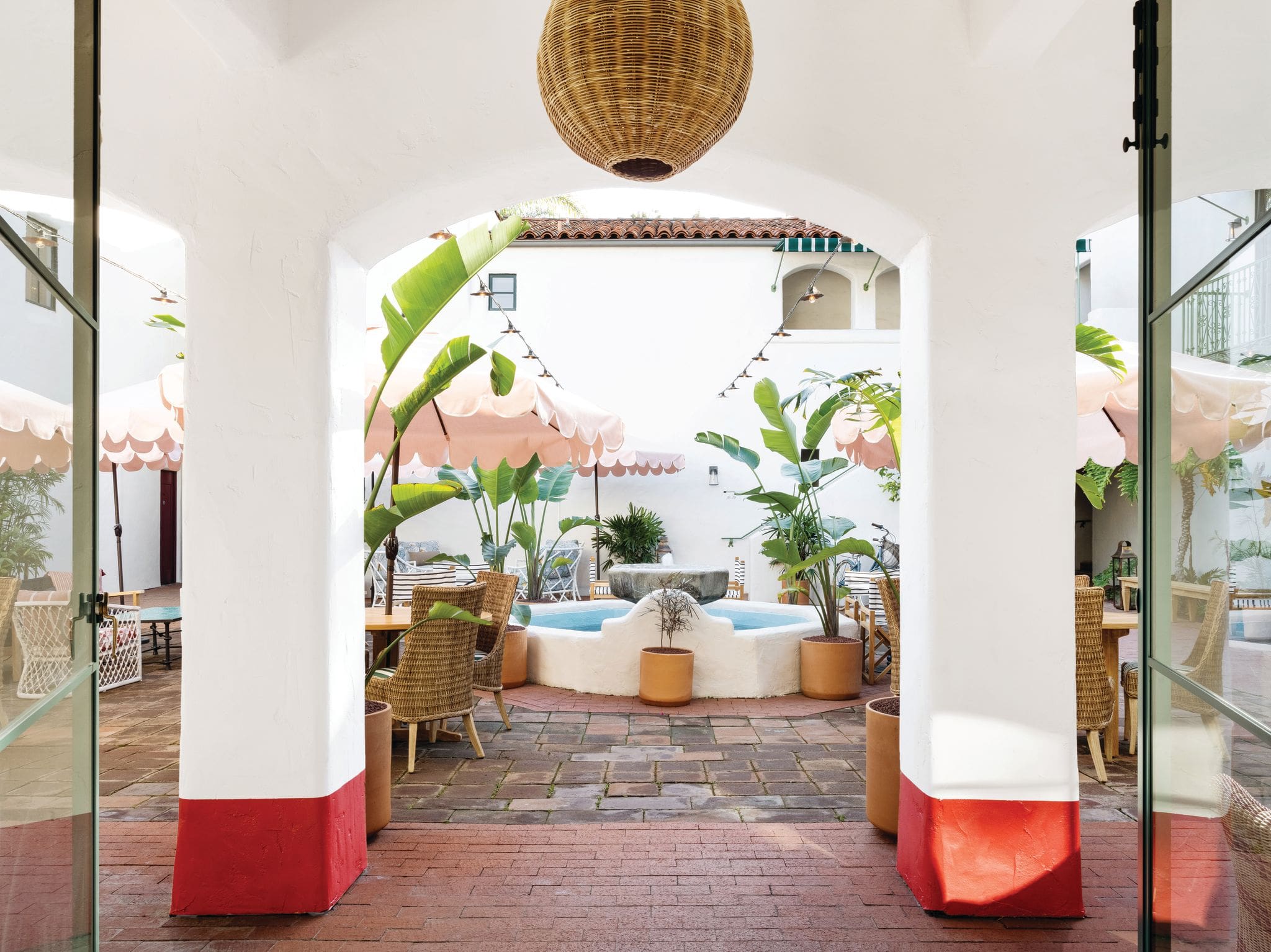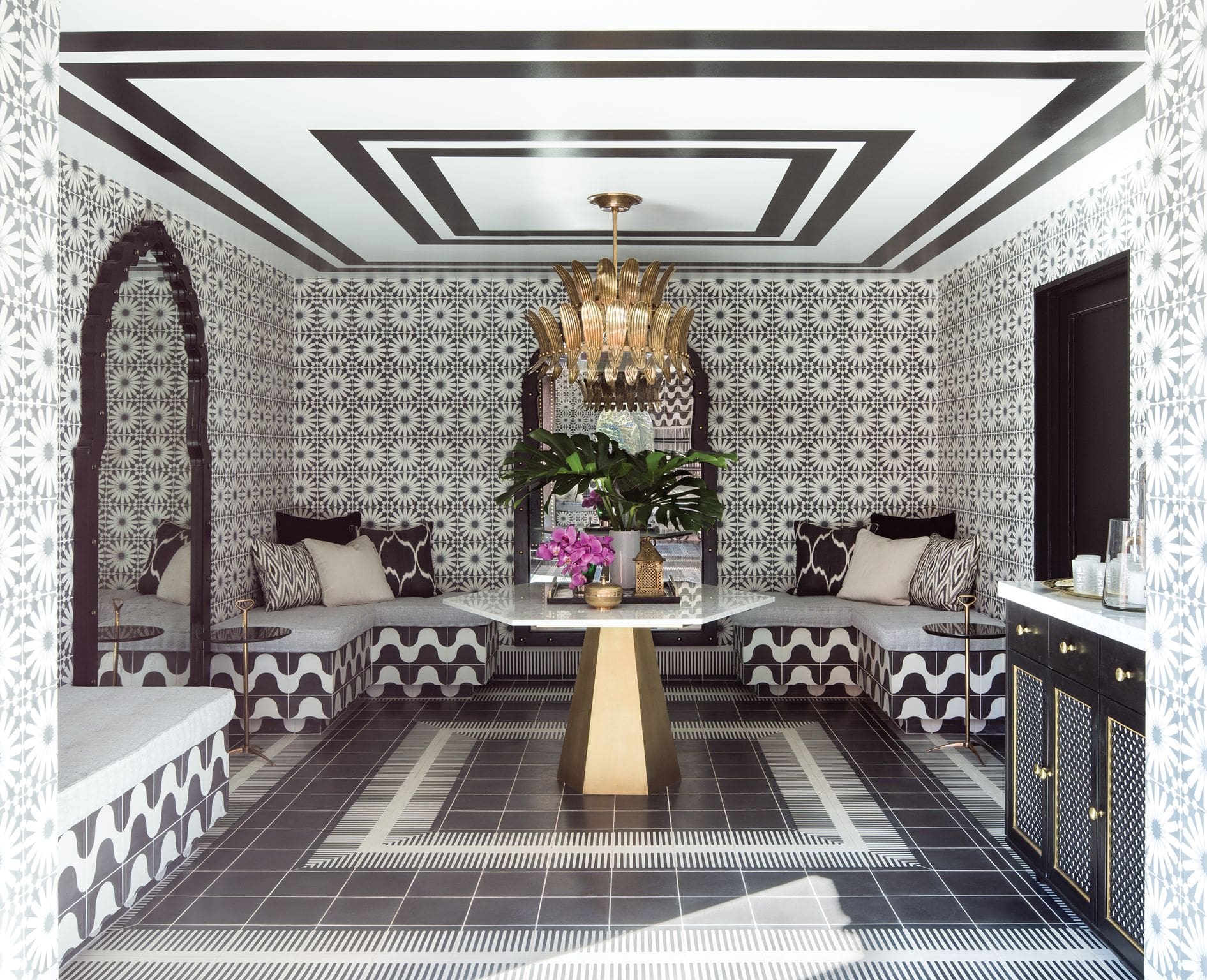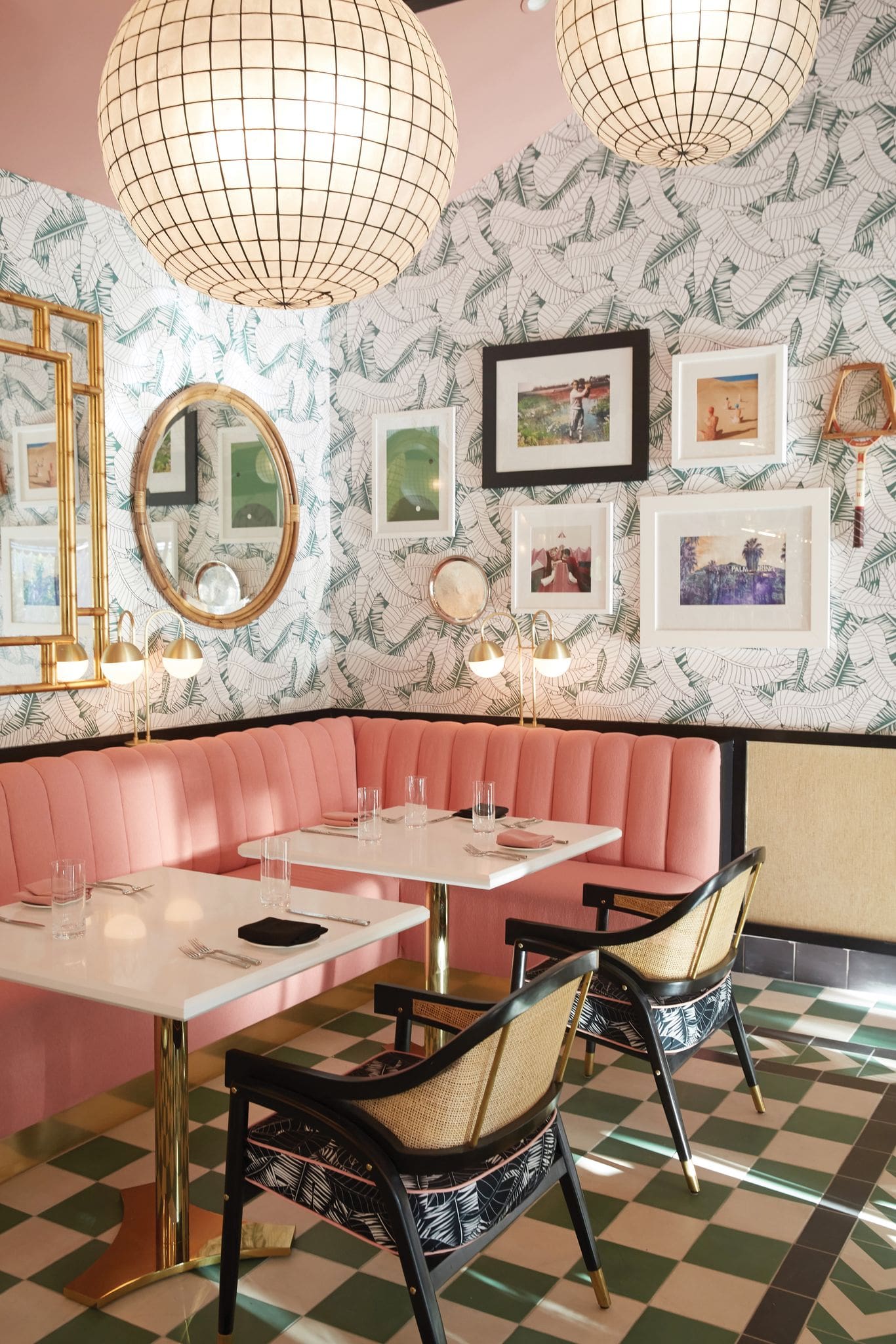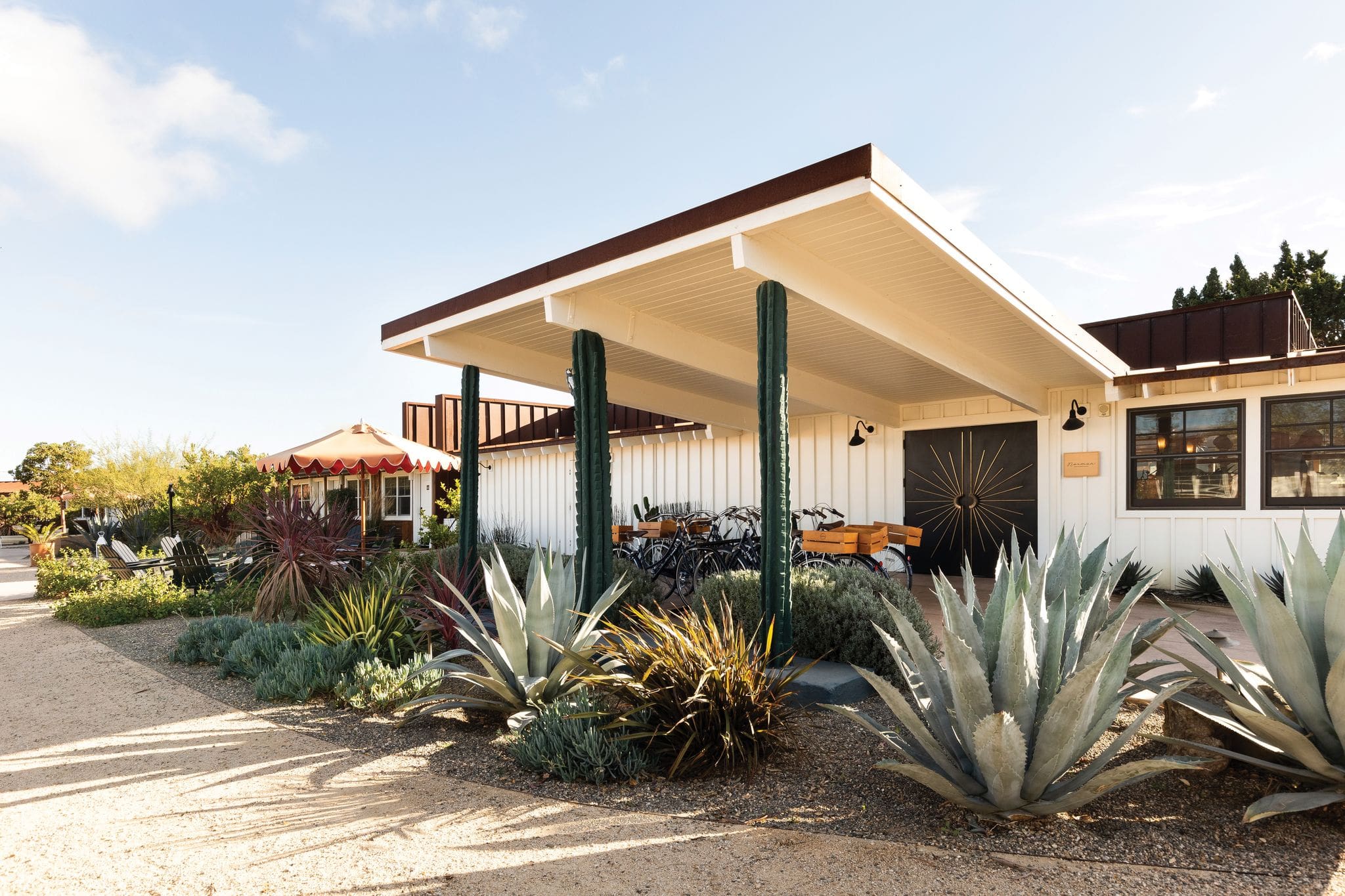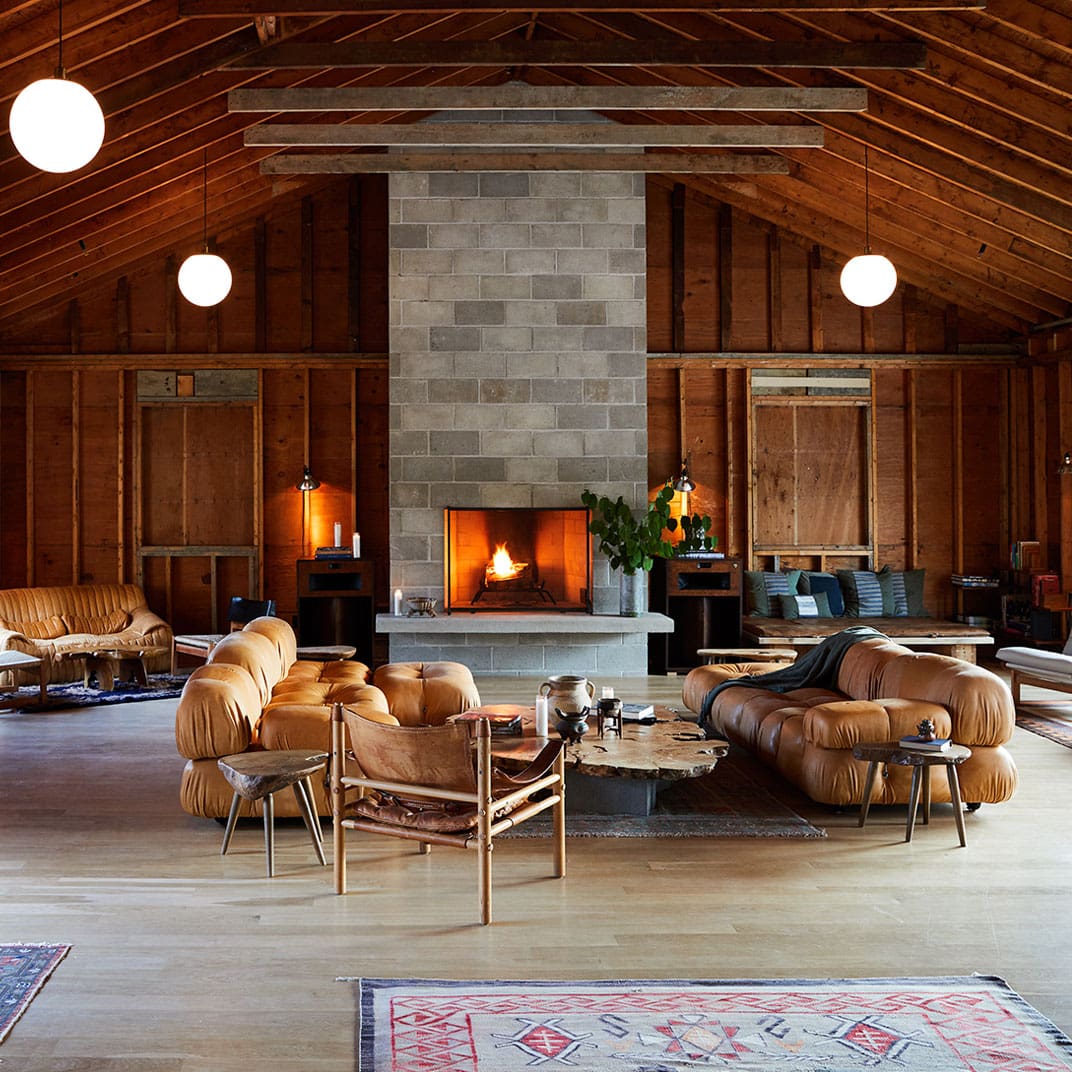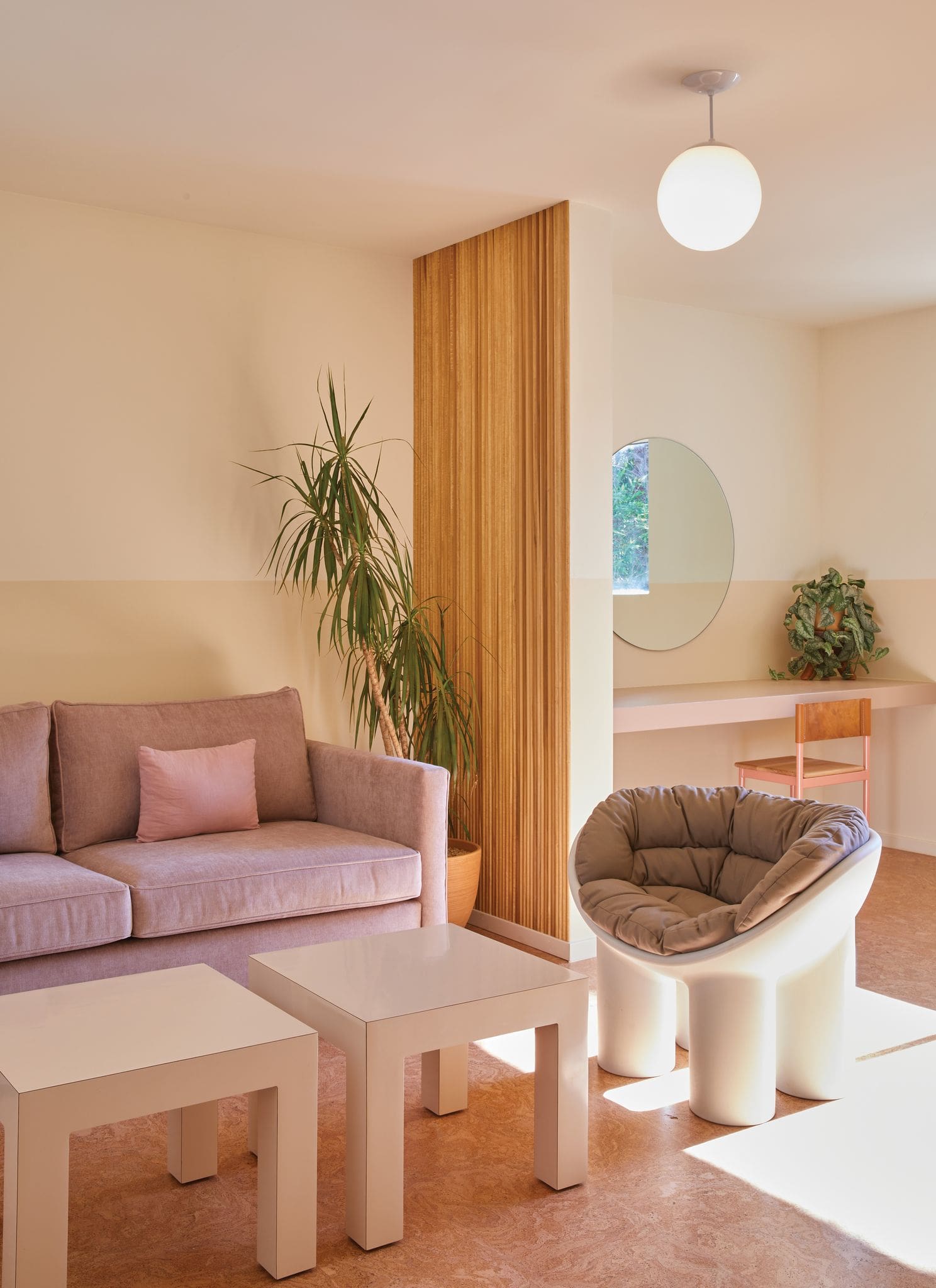While we all love luxe getaways, there’s no place like home — especially a friend’s super stylish home. Hoteliers are tuning in to this craving, clicking their heels together to create more intimate, meaningful accommodations. Even in the most lavish of destinations, natives and guests alike are gravitating away from grandeur and toward something subtler and more spirited: the neighborhood inn.
On a balmy weeknight in Santa Barbara, four friends are huddled together on a tufted sofa in the Palihouse micro-lobby, which looks more like a living room. Collected portraits grace the pale blue walls, a random bowl full of tennis balls rests in the corner, and Saltillo tile floors, rattan light fixtures and leafy palms feel unmistakably Old California. As it gets late, the locals plan their next visit, gushing over their new favorite spot in town. It’s like home, one quips, only better.
Neighborhood inns are in again. And while they’ve always been residential in spirit to make guests feel at home, they’re being taken up a notch by creative owners, designers and influencers. A detour from flash, grandeur and opulence, these smaller hotels feel cozy, personal and drenched in nostalgia — think honor bars, passed-down banana bread recipes, and playlists personally curated by the proprietor. Most importantly, they come with an unwavering sense of place. At every turn, there’s a thoughtful, often quirky detail designed to reflect its destination and offer this gentle yet affirmative reminder: You are here.
Up Close and Personal
One thing innkeepers love to hear over and over again is that their property has personality. Just as they seek to steep a sense of place into their hotels, they also want to infuse heart and soul — their heart and soul, that is. Which means they’re often the only ones fit to dream up the design.
For Avi Brosh, former real-estate developer turned Palisociety founder, design gave him the confidence to create his empire of neighborhood inns. After losing his savings in the recession, he took his last property, Palihouse West Hollywood, and learned the hospitality industry fast, vowing he’d be the only one to design his inns.
“I’m not a classically trained designer,” Brosh says. “My sensibility is more residential in nature, and I’m trying to create personality in these spaces. You do that by mixing styles and periods. And you include unexpected things they would never teach you in design school — like a bowl of tennis balls,” which he puts in all of his hotels.
Brosh’s aesthetic is eccentric, layered and curious. Each of his outposts from the Pacific Northwest to the East Coast is unique in architecture and style, always echoing its locale. To wit: Miami’s is set in a restored art deco building; Seattle’s is across from Pike Place Market with its own coffee house; and Silver Lake’s is a sparkling Los Angeles oasis. One commonality? All pull from nostalgia.
When creating Palisociety, Brosh tapped memories of traveling with his family on a shoestring budget to European-style inns that felt more like homes than hotels. This helped frame each of his highly stylized, very un-corporate-feeling boutique properties, where the design is entirely schemed by him, down to the color palette, the wallpaper, the umbrella stripes, the bar menu and that inexplicable bowl full of tennis balls.
“I wanted this company to be very proprietor-driven,” Brosh exclaims. “I didn’t want it to feel cold and corporate. I didn’t want it to feel transactional. I want you to come and understand a little piece of me as a person.”
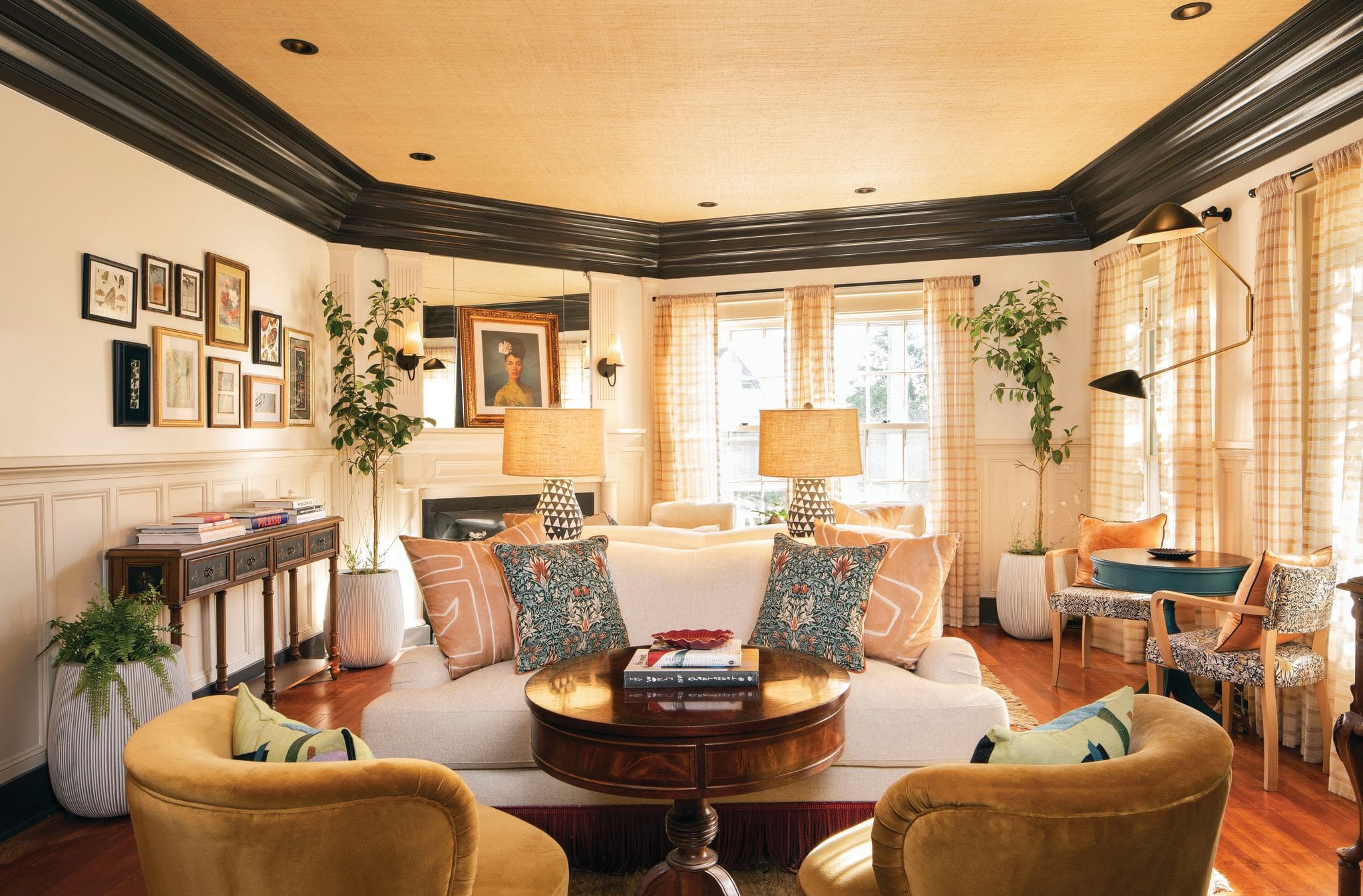
Photography provided by Life House
Innkeepers get to be wildly expressive within their walls while also breaking the mold in their environments, even in the most high-end markets. Life House Nantucket, for example, is a complete detour from the island’s elite old guard properties. It’s one of the micro inns under the Life House group, founded by Rami Zeidan in 2017 with a mission to “connect people with new places by celebrating the heritage of the neighborhood.” On Nantucket, the team transformed a former sea captain’s house into a 14-room “nonchalant coastal cottage” with a library and a lush garden terrace just a stroll from downtown’s cobblestone streets. Here, you feel truly submerged in local life, not just on the periphery.
And that insider feel is exactly what the original inn always aimed to do. Proprietors have been putting their stamp on their spaces since the beginning. What started across the pond with English pub owners offering weary travelers room, board and a house pint evolved into an entire genre of beloved neighborhood hangouts. Inns became highly personal spots that were more than just a place to sleep. They were fun, with locals dropping by for a pint or two.
By the time the concept moved west, business got even more personal, with notable figures taking the keys. When actress Doris Day took over Carmel’s 1906 Cypress Inn, the late animal activist left such a mark that the pet-friendly hotel offers vintage sidecar biking experiences for dogs to this day. Plus locals still frequent her Mediterranean terrace for happy hour. As centuries have passed and our world has become oversaturated with sites offering limitless luxury, proprietors are once again dialing down on size to deliver a more intimate experience.
“This idea of creating the best version of the neighborhood inn backed by a very sophisticated operating model is working,” affirms Brosh, who believes that designing by instinct helped lead to his success.
Take Palihouse Santa Barbara, which is his eighth hotel and set in the historic Presidio neighborhood. It opened its doors in 2021 during the height of the pandemic yet has been sold out almost every weekend. Bold design moves have been as important as big business decisions, enticing guests to linger longer in the lobby to take it all in. While Brosh laughs that there’s a fine line between collector and hoarder, he thinks it’s the personal touches that people remember: the heirloom pieces, the eye-catching portraits, the vintage photographs, the bowls full of shells (or tennis balls!). It’s his personal point of view that’s executed ever so elegantly and distinctively that puts that signature stamp on each property.
“My blood, sweat and tears are in every single hotel,” he says. “When they’re open, it’s a collapse-on-the-floor type of situation. I’m all in.” Going all in isn’t easy. And it isn’t for everyone. “There’s a tension to good taste,” Brosh adds. “You can’t teach that. You either see it, or you don’t. I think the way you get there is by being somewhat fearless.” And if the vision isn’t there, the best move is to let someone else make it shine.
Star Power
Curating interiors to a high level of sophistication takes a careful eye, and not every hotelier is born with it. Rather than infuse a point of view that simply isn’t there, smart innkeepers call in help, turning to the pros. Outsourcing good taste to a true designer can be a win-win, especially when that someone is a fearless expert.
It’s no secret that many top-tier hotels are designer-driven — think Kelly Wearstler, Kit Kemp, Ken Fulk, Jonathan Adler and Philippe Starck. In taking a page from this playbook, proprietors are enlisting big names to rethink their small spaces. Mark D. Sikes recently put his signature blue-and-white spin on Holiday House, the 1951 Palm Springs inn designed by acclaimed architect Herbert W. Burns. Nathan Turner, meanwhile, reimagined part of the old Alisal Ranch in California’s Santa Ynez Valley, layering in modern Western decor, textiles and antiques for a look that would make even Ralph Lauren swoon.
Million Dollar Decorators star Martyn Lawrence Bullard, known for his more-is-more mentality, successfully pulled off small-scale pattern play at three California inns: Casa Laguna; the Sands in Palm Springs; and the recently opened Prospect in Hollywood, where fearless decorating is on full display. “When it comes to small-scale design, restraint is something we all have to learn,” he notes. “But mostly, it’s about not being afraid to just go for it.”
The Prospect bears plenty of Old Hollywood nods; suites are themed for movie stars who lived in the building or down the street, like Greta Garbo and Elizabeth Taylor. Bullard imbued guest quarters with whimsy and luxury, using stripes, pattern and chinoiserie for that in-room experience he thinks you can only really get at a boutique property.
“The whole idea of travel is to garner a sense of place, and the beauty of small hotels is that they allow you that luxury,” explains Bullard, who loves to wallpaper the ceiling, throw a chandelier off to one side for romance, or curate a cocktail bar with indulgences and maybe even a bottle of absinthe. “It’s the little elements that make the American inn an exciting place to visit right now. For me, it’s the curation of how things all come together and the excitement of the unknown.”
If predictability is a buzzkill for boutique hotels, color is the antidote. And Bullard’s inns, like Brosh’s, are full of it. In full disclosure, Bullard admits sometimes as a guest he likes to stay at the Four Seasons because you know what you’re going to get. But as a designer, it’s the unpredictable interplay of color, fun and surprise that gets him going.
“People come to a hotel to stay a night or two, and they want fantasy,” he muses. “You want it to feel welcoming, luxurious, unexpected and enveloping so they never want to leave.” Building romance and fantasy is a talent, and it’s what Bullard believes really hooks the guest, making the memory and prompting repeat visits. But nothing injects more personality into an inn than its locale.
Location, Location, Location
A neighborhood inn only works if it expertly mirrors its surroundings. For Bullard, that means bold Moroccan tiles and lanterns to play off the 1900s California Mission roots of Casa Laguna. For Brosh, it’s Mediterranean-meets-art-deco furnishings in Miami. And for most designers, it’s all about grounding a property with a sense of place.
When uber chic Auberge Resorts desperately needed to perk up one of its oldest establishments, Connecticut’s historic Mayflower Inn, they tapped a trusted pro who knows how to create a persona out of a place. Celerie Kemble — who recently designed the Dominican Republic’s playful Playa Grande Beach Club (the subject of her new tome, Island Whimsy) — came onboard eager to bring the property into the modern era, bidding goodbye to stuffy white glove service and saying hello to color in a fresh new way.
“We wanted unpretentious, informal and very, very pretty, in a flip-of-the-hand way,” notes Kemble, who piled in perky pinks, spring greens and sky blues during the refresh. In respecting the roots of the 1894 inn, which at one time served as a boarding school, she also knew what it wouldn’t be. Authentic would not mean pastoral 1800s. There would be no white tablecloths with vast sightlines in the dining room. Instead, Kemble channeled sunny country picnic moments, literally opting for earthy bugs and oversize leaves in her patterns.
To honor the history, Kemble retained original elements then layered in vintage books, cracked picture frames, collected mirrors, hooked rugs and paper flowers. It’s Little Women meets Alice in Wonderland, with plenty of curiosity at every turn. So much so that guests may be surprised to find out the inn is under the umbrella of a big corporation.
“It feels like there’s an invisible host, instead of being run by a hotel group,” Kemble quips. “People are hungrier for intimacy than they are for grandeur. Grandeur puts you out of sorts; it reminds you that you’re a temporary consumer. Intimacy is life experience. To make something authentic, you have to make something new.”
And new meant color and pattern everywhere, which she applied through contract-grade fabrics and wallpapers from Schumacher and Sister Parish. While it may feel like a kaleidoscope, there’s a connected thread of inspired hues that reflects what’s outside the window in the Connecticut countryside. Adds Kemble: “My theory is that your eye is at rest when there’s a lot of color, just like in nature. When it’s too controlled, it makes me anxious.”
Looking out the window was all the inspiration designer and Surf Shack author Nina Freudenberger needed for her two recent California hospitality projects. “White Water was inspired by the incredible beauty and nature surrounding the inn, particularly Moonstone Beach,” she says. “The colors were drawn from the seagrass, the boardwalk and the Monterey pine. For San Luis Creek Lodge, I was blown away by what an incredible place San Luis Obispo is — so sophisticated and totally connected to nature. I wanted each room to feel that same way.”
To accent the furnishings, she filled guest rooms with accessories by local artisans for a West Coast spin, ensuring everything from the palette to the pillows reflected the views. It was important that the spaces feel like a getaway yet warm and residential. “Inns should feel more domestic,” Freudenberger declares. “As opposed to just providing a place to rest your head, the environment should respond on a micro scale to what’s happening in the area. That allows the traveler to feel connected and inspired by their experience.”
Sometimes travelers are looking for a truly niche experience, allowing creatives to really let loose. Boston-based designer Rachel Reider teamed up with Lark Hotels to give their inns distinctive destination-driven personality. Nearly all of the brand’s boutique properties are in New England, from a seafaring Colonial in Kennebunkport, Maine, to the après-ski-esque Field Guide Lodge in Vermont to the retro Hotel Salem set in a former Massachusetts department store. The Maine and Nantucket outposts sport preppy Vineyard Vines suites, where decor is filled with stripes and swordfish, and the window fabric trim is made from the beloved belts, letting both brand and location play host. A bit much? Perhaps. Staying in a brand-driven suite on an island is akin to wearing the band T-shirt to the concert. But it’s a trend proprietors are cashing in on — especially when they have a growing portfolio of properties to play with.
Chain Reaction
It’s almost a dirty word in the hospitality industry, but cringy or not, “chain” is very often the secret to the modern innkeeper’s success. Far from the Hyatts and Marriotts of the world, smaller hotel chains like Lark, Life House and Palisociety are able to keep doing what they do well by scaling. For Brosh, every time he opens another Pali property, it gets easier and easier. Not just because of the learning curve, but because he has a centralized system and core staff in place.
“The status of the neighborhood hotel has always been fractured,” notes Brosh, adding that independent innkeepers, usually a couple, simply did too much minding their single property. While this can add up to a memorable experience (cue the adorable family-run inn on an Italian hillside!), those owners are doing all the bookings, billing and banking for one establishment. Sure, it’s charming, but it’s also highly inefficient.
“Our 25-room hotel has the same horsepower as a 250-room hotel,” Brosh explains. “Even though it feels local, inspired, bespoke, personal and purposeful, it’s being done with a very sophisticated mindset in terms of all of the banker-type things you have to do when you’re building hotels. And the industry rewards scale.”
Scaling has rewarded Brosh with not just financial success, but also time to create. Time to spend on inventive details: the bistro chairs, the perfect cup of coffee, the bowls full of tennis balls. And time for his staff (who don’t wear name tags or recite canned scripts) to spend with guests, since all the business is handled behind the scenes. Says Brosh: “We approach the entire portfolio of hotels as a collection, and because of that, we’re able to operate at a very sophisticated level. Nobody here has to run around with a bunch of keys. They just focus on making sure people have a good time.”
This kind of authentic presence is a big part of the secret sauce for cult favorite West Coast hospitality group Shelter Social Club, too. Founded by Kenny Osehan, it’s the poster child for successfully scaled family businesses; his parents, aunt and cousins own nearby inns and eateries under the brand, allowing for plenty of cross-promotion.
While each spot, including the Ojai Rancho Inn and recently opened Capri Hotel, is independent in design and spirit, they all have cool communal areas — be it the lobby, a poolside bar or an inviting fire pit — that lend a clubby atmosphere like a laid-back house party. And there’s always a familiar face at the door. “We make personal connections with each person who walks in, letting people feel instantly at home,” says Osehan, who has mastered the art of modern innkeeping. “We have a lot of repeat clientele who get to know our team and come back just to hang out with us.”
Another undeniably cool hangout? The old-school motel. The resurgence of the roadside inn (see sidebar below for our top picks) has revived relics that may have otherwise been demolished, giving way to shiny resorts or mega-chains. Instead, forward-thinking entrepreneurs are getting their hands on them first.
Kimberly Walker transformed a dusty 1954 hilltop motel into the now sought-after Skyview, complete with vineyard views and local wines. Perched high above California’s Highway 101 in Los Alamos, the property was previously so notoriously abandoned it had long ago been dubbed Bates Motel. Today, it’s wildly occupied with modern amenities and just enough weirdness to draw crowds every weekend. There aren’t any shower curtains, but in a nod to Alfred Hitchcock’s Psycho, the restaurant is named Norman.
“I think of small inns as the hotel equivalent of a dinner party,” explains Walker, who also operates the nearby Granada and Hotel Ynez under the Nomada Hotel Group, with two more renovations underway. “A well-executed inn is the owner’s design experience created for their guests. It’s an intimate environment, usually not suited for the masses.” And that’s the crux: These neighborhood inns aren’t made for the masses. She adds: “People are craving spaces with stories to tell. Properties rooted in the history of the locale are timeless and will keep their relevance as long as they evolve with the guest.”
With Skyview’s evolution came farm-to-table menus, craft cocktails, cool bikes at the ready and private outdoor showers. Yet eclectic nods to the past abound, from vintage room keys to the original neon sign, once again alerting: You are here. And like most of these revivals, once you’re there, you won’t want to leave. It’s like home — only better.
The New Era of Roadside Motels
The American motel is having its second moment in the spotlight, and it’s even brighter than before. Thanks to the pandemic bringing back road trippers, these low-budget, high-design pit stops are getting lit up with “no vacancy.” These iconic pieces of Americana are absolute reflections of their location, thoughtfully salvaged by design-minded hoteliers for today’s traveler. Here are 5 to visit.
Tourists
This woodsy Berkshires retreat tops many designers’ bucket lists, and for good reason. Inspired by the classic roadside motor lodge, the 48-room sixties-era modern country inn is immersed in nature, with trailheads out each door for endless adventures — that is, if guests can leave the fireside lodge, where vintage Mario Bellini Camaleonda sofas beckon.
Capri Hotel
The latest Shelter Social Club offering, this 30-room 1960s motel reopened in 2020. The California-meets-Mediterranean-oasis vibe is everywhere, from the lush landscaping to the pastel palette inspired by Italian design of yesteryear. The original rock fireplace and low-slung seating in the lobby feel like a groovy, cinematic step back in time.
Joie Inn
Ashley Petrone, the influencer-cum-designer behind @arrowsandbow, has shared with the world (well, at least her nearly 710,000 Instagram followers) her recent journey of buying and redesigning a four-room inn on the Gulf of Mexico. Opened in 2021, this selfie-ready spot is decked out in a “sunset and seashell” palette, with painted rainbows and rattan furniture.
Cuyama Buckhorn
Yes, this 21-room inn is in the middle of nowhere, but people still come for the wildflower blooms and to experience this relic of a 1952 motel reenergized by co-owner and designer Ferial Sadeghian. She restored the original sign and saloon, even recreating a wall of vintage taxidermies. The greenhouse and poolside cocktail bar nod to the local farm-to-table dining.
The Drifter
Midcentury architecture meets the Big Easy at this 20-room 1956 property, which was reimagined in 2017. Inspired by the Beat Generation, the Drifter is full of carefree moments — from its creative murals to its hopping pool scene, not to mention the global cafe, frozen cocktails, and rotating food trucks on call.




